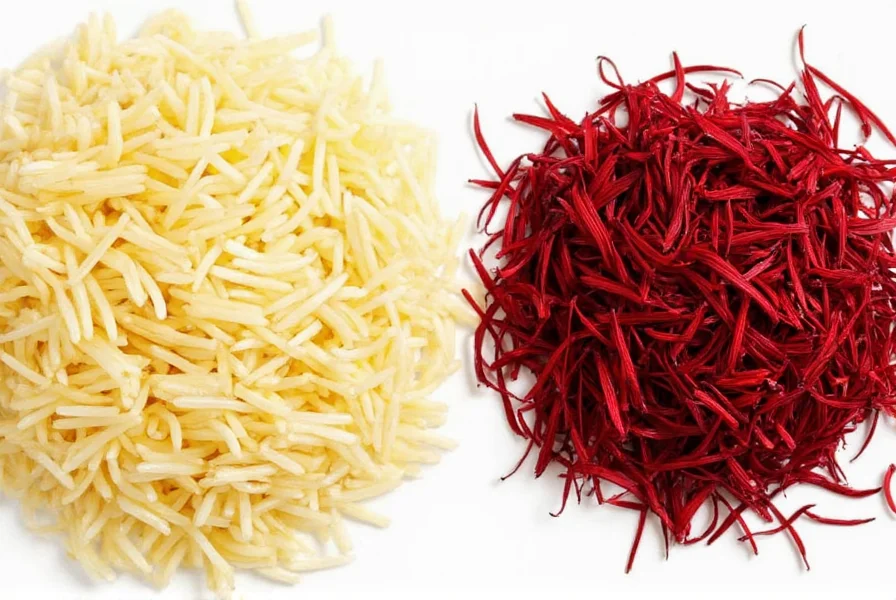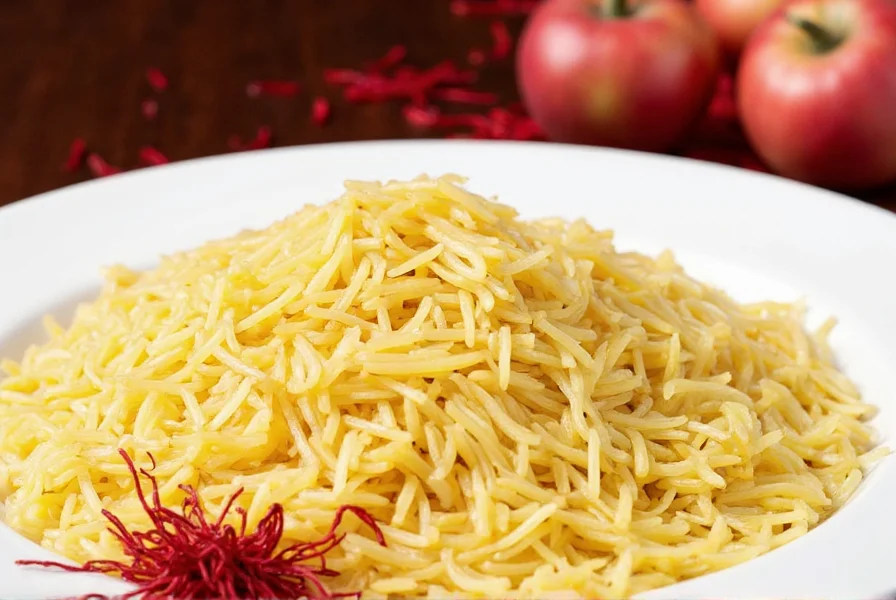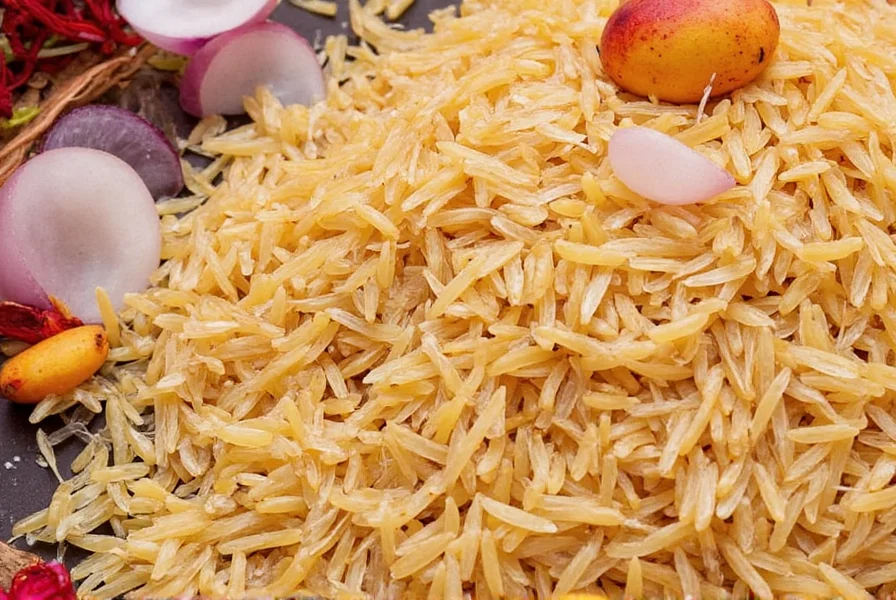Many home cooks and food enthusiasts confuse these two premium ingredients due to their association with gourmet cuisine and similar-sounding exotic origins. Understanding the fundamental differences between basmati rice and saffron is essential for proper culinary application and avoiding costly purchasing mistakes.
What Exactly is Basmati Rice?
Basmati rice (Oryza sativa) represents a specific category of aromatic long-grain rice cultivated primarily in the Indian subcontinent. The name "basmati" translates to "fragrant" in Hindi and Urdu, perfectly describing its distinctive popcorn-like aroma. Authentic basmati rice features several key characteristics:
- Extra-long slender grains that elongate significantly when cooked (up to twice their original length)
- Distinctive nutty, floral aroma due to the presence of 2-acetyl-1-pyrroline
- Non-sticky texture when properly prepared, with separate, fluffy grains
- Protected Geographical Indication (PGI) status for authentic Indian and Pakistani basmati
- Traditional aging process (1-2 years) that enhances flavor and texture
Among the premium basmati varieties, you'll find Traditional Basmati, Pusa Basmati 1121 (known for exceptional grain elongation), and Dubar Basmati. Each offers slightly different culinary properties while maintaining the signature fragrance that makes basmati rice prized in biryanis, pulaos, and other specialty dishes.

Understanding Saffron: The Golden Spice
Saffron represents something entirely different from basmati rice. This precious spice consists of the dried stigmas of the Crocus sativus flower, commonly called the "saffron crocus." Harvesting saffron requires immense labor, as each flower produces only three stigmas, and it takes approximately 150,000 flowers to yield just one kilogram of dried saffron.
The world's finest saffron comes from Iran, which produces over 90% of global supply, followed by smaller quantities from Spain, India (Kashmir), and Greece. Saffron's value stems from:
- Intense golden-yellow coloring power (just a few threads color entire dishes)
- Unique flavor profile combining hay-like, metallic, and slightly bitter notes
- Rarity and labor-intensive harvesting process (entirely by hand)
- Historical significance as both spice and medicinal ingredient
- Chemical compounds like crocin (color), picrocrocin (taste), and safranal (aroma)
Key Differences Between Basmati and Saffron
| Characteristic | Basmati Rice | Saffron |
|---|---|---|
| Nature | Cereal grain (rice) | Spice (flower stigma) |
| Primary Growing Regions | India, Pakistan | Iran, Spain, Kashmir, Greece |
| Price per Kilogram | $3-$10 (premium varieties) | $3,000-$15,000 |
| Primary Use | Staple grain | Coloring agent and flavoring |
| Storage Requirements | Cool, dry place (years) | Airtight container, dark, cool (2-3 years) |
| Authenticity Indicators | Grain length, aroma, elongation when cooked | Deep red threads, bitter taste, strong aroma |
How Basmati Rice and Saffron Work Together in Cuisine
While basmati and saffron are distinct ingredients, they frequently appear together in premium dishes, particularly in Middle Eastern, Indian, and Persian cuisines. The most famous application is saffron rice, where:
- Saffron threads are soaked in warm liquid (water, milk, or broth) to release color and flavor
- This infused liquid is then used to cook premium basmati rice
- The result is beautifully colored golden rice with subtle floral notes complementing basmati's natural fragrance
Chefs preparing authentic biryanis, pulaos, or Persian tahdig often use this technique to create visually stunning and aromatic rice dishes. The key to success lies in proper saffron preparation—never add dry threads directly to rice, as they won't properly infuse the dish.

Identifying Authentic Products: Avoiding Common Pitfalls
Both basmati rice and saffron face significant counterfeiting issues. Understanding how to identify authentic products prevents costly mistakes when purchasing these premium ingredients.
For basmati rice: Look for official certification marks like the Indian Basmati Export Development Foundation (IBEDF) logo or Pakistan's Basmati Rice Exporters Association certification. Authentic aged basmati should have a distinctive aroma even when dry, with grains that are long, slender, and uniform in size.
For saffron: Perform the water test—real saffron slowly releases a golden-yellow color in warm water while maintaining thread integrity. Fake saffron (often made from marigold petals or food coloring) will immediately turn water red or lose color rapidly. Genuine saffron threads should be deep red with orange tips, have a strong hay-like aroma, and taste slightly bitter.
Maximizing Flavor: Proper Usage Techniques
To get the most from these premium ingredients, follow these professional techniques:
- For basmati rice: Always rinse thoroughly before cooking to remove excess starch. Soak for 30 minutes to ensure even cooking and maximum grain elongation. Use a 1:1.5 rice-to-water ratio for perfect texture.
- For saffron: Never add dry threads directly to dishes. Instead, crush a few threads and steep in 2-3 tablespoons of warm liquid (water, milk, or broth) for 15-20 minutes before adding to your recipe. This maximizes color release and flavor extraction.
- When combining both: Add the saffron infusion during the final stages of cooking basmati rice to preserve the delicate saffron aroma that can dissipate with prolonged heat exposure.
Common Misconceptions Clarified
Several persistent myths surround these ingredients. First, no such thing as "basmati saffron" exists as a single product—this is always a misunderstanding. Second, while both are premium ingredients, their price points differ dramatically; saffron costs thousands of times more per weight than basmati rice. Third, not all long-grain rice is basmati—only specific varieties grown in designated regions qualify as authentic basmati.
Conclusion
Understanding the distinction between basmati rice and saffron prevents common culinary mistakes and ensures proper usage of these premium ingredients. While they serve completely different purposes—one as a staple grain and the other as a luxury spice—they complement each other beautifully in traditional dishes when used correctly. By recognizing their unique properties, proper preparation methods, and authenticity indicators, home cooks can elevate their culinary creations with confidence. Whether preparing a simple saffron rice or an elaborate biryani, knowing how to properly select and use these ingredients makes all the difference in achieving authentic flavors and textures.











 浙公网安备
33010002000092号
浙公网安备
33010002000092号 浙B2-20120091-4
浙B2-20120091-4